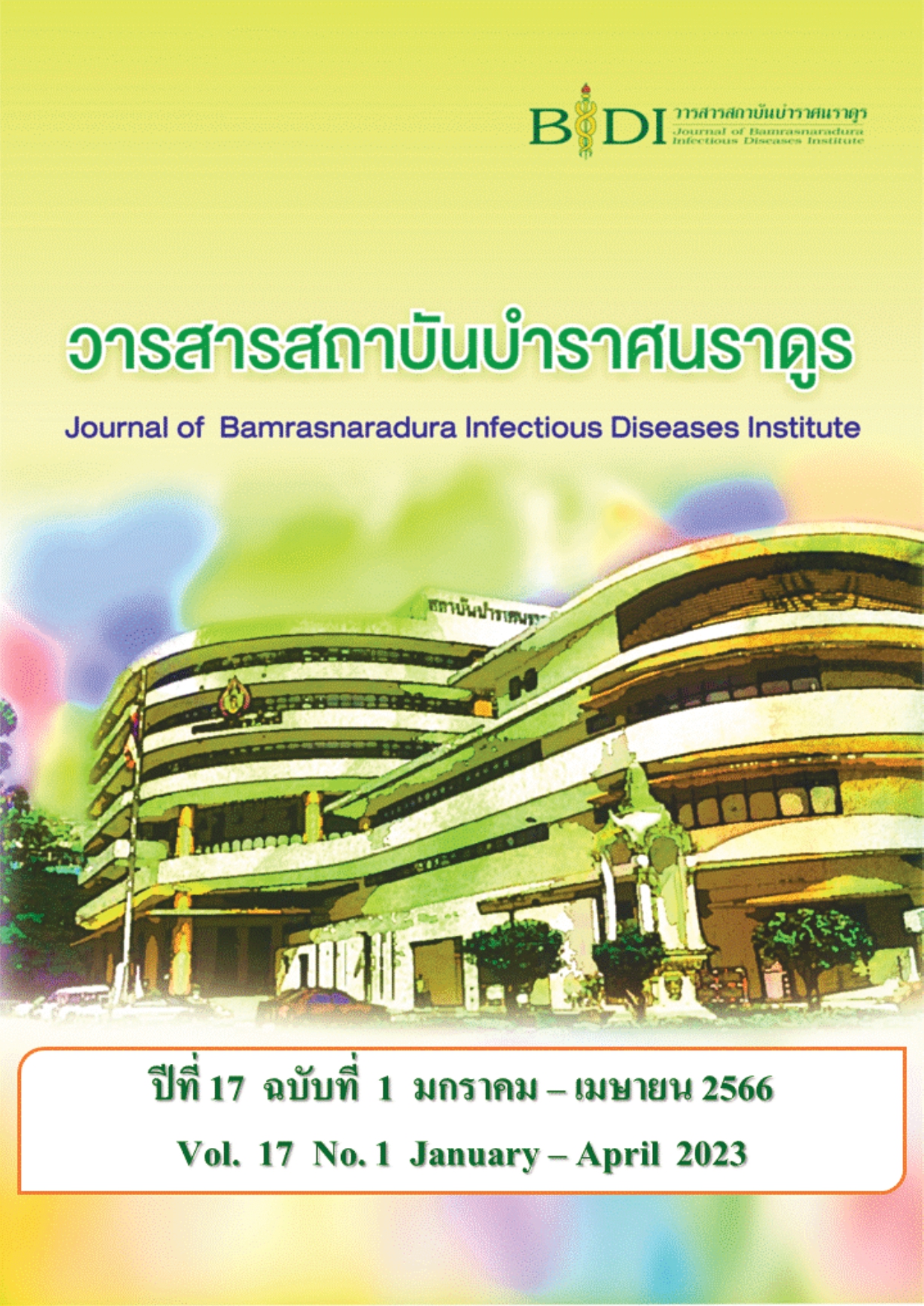Association of modifiable behavioral risks and cardiovascular disease in Thai population
Main Article Content
Abstract
To demonstrate impact of modifiable risks for cardiovascular disease in Thai population, we conducted a two years case-control (1: 2) study, from June 2016 to June 2017. The study was conducted in 11 Thai provincial hospitals. Case-control study was used to demonstrate the odds ratio of the risks. 995 cases of newly diagnosed cardiovascular disease within 1 month were enrolled with 997 control cases. Both groups were matched for age range of 35 to 80 years. The results of this study, Thai patients with cardiovascular disease, found that age and socioeconomic factors were associated with cardiovascular disease. Family history of non-communicable diseases (NCDs) had very high association with cardiovascular disease. Important behavioral factors include smoking, especially having more than 20 pack-years, lack of physical activity and greasy food consumption were associate with cardiovascular disease. The study could not demonstrate the associated with alcohol consumption and cardiovascular disease. The results suggested that Thai cardiovascular disease might have more association with family factors and behavioral factors. The modifiable risk in Thai are stop smoking and promote adequate physical activity.
Article Details
References
Wongwannatakul W, Suriyawongpisan W, Thummarungsee T. Report on NCDs situation: health and social crisis [Internet]. 2014 [cited 2016 April 30]. Available from: http://ihppthaigov.net/DB/publication/attachbook/165/chapter1.pdf. (in Thai)
The Heart Association of Thailand under the Royal Patronage. Thai Clinical Practice Guidelines 2014. Bangkok: The Heart Association of Thailand under the Royal Patronage; 2014. (in Thai)
Tonghong A. Situation report on NCDs. Bangkok: Bureau of Epidemiology Department of Diseases Control MOPH; 2013. (in Thai)
National Health Security Office. Report on Universal Health Insurance Scheme 2012. Nontaburi: Sahamitr Printing Co, LTD; 2012. 184 p. (in Thai)
Bureau of Non-communicable Diseases. Annual Report 2556: Bangkok; 2013. (in Thai)
OrnwanrayaPummisrikeaw. Risk factors of ischemic heart diseases and diabetic. Nursing, Health, Education Journal Udontani 2012. (in Thai)
Sampaukin N, Chartprasert D. Influence of risk communication on NCDs health behavioral. Journal of Public Relations and Advertising 2014; 7(2): 38-67. (in Thai)
Jalayondeja W. Hyperion and Physical exercise [internet]. 2008 [cited 2016 April 30]. Available from: http://www.doctor.or.th/article/detail/5833. (in Thai)
Fleming MF, Barry KL, MacDonald R. The alcohol use disorders identification test (AUDIT) in a college sample. Int J Addict. 1991 Nov; 26(11): 1173-85. doi: 10.3109/10826089109062153.
Claussen B, Aasland OG. The Alcohol Use Disorders Identification Test (AUDIT) in a routine health examination of long-term unemployed. Addiction. 1993 Mar;88(3):363-8. doi: 10.1111/j.1360-0443.1993.tb00823.x.
Heatherton TF, Kozlowski LT, Frecker RC, Fagerström KO. The Fagerström Test for Nicotine Dependence: a revision of the Fagerström Tolerance Questionnaire. Br J Addict. 1991 Sep; 86(9): 1119-27. doi: 10.1111/j.1360-0443.1991.tb01879.x.
Bull FC, Maslin TS, Armstrong T. Global physical activity questionnaire (GPAQ): nine country reliability and validity study. J Phys Act Health. 2009 Nov; 6(6): 790-804. doi: 10.1123/jpah.6.6.790.
Fagerstrom K. Commentary on Baker et al. (2012): Assessing dependence-are specific criteria for nicotine enough or do we need to consider its forms of administration? Addiction. 2012 Feb; 107(2): 276-7. doi: 10.1111/j.1360-0443.2011.03735.x.
Pender NJ, Walker SN, Sechrist KR, Frank-Stromborg M. Predicting health-promoting lifestyles in the workplace. Nurs Res. 1990 Nov-Dec; 39(6): 326-32.
Chronic diseases surveillance report [Internet]. Bureau of Epidemiology, Department of Diseases Control, Thailand. 2012. Available from: http://www.boe.moph.go.th/files/report/20140109_40197220.pdf. (in Thai)
Mendis, Shanthi. Global status report on noncommunicable diseases 2014: "Attaining the nine global noncommunicable diseases targets; a shared responsibility" [Internet]. 2014 [cited 2016 April 30]. Available from: http://apps.who.int/iris/bitstream/10665/148114/1/9789241564854_eng.pdf.
E Lyon D, Mohanraj L, Kelly DL, Elswick R Jr. Health Promoting Life-Style Behaviors and Systemic Inflamma-tion in African American and Caucasian Women Prior to Chemo-therapy for Breast Cancer. Health Promot Perspect. 2014 Jul 12; 4(1): 18-26. doi: 10.5681/hpp.2014.003.


